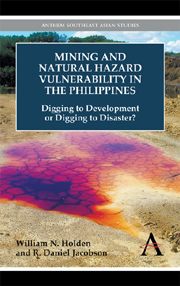 Mining and Natural Hazard Vulnerability in the Philippines
Mining and Natural Hazard Vulnerability in the Philippines Book contents
- Frontmatter
- Contents
- Acknowledgments
- List of Tables and Figures
- List of Acronyms
- Introduction
- Chapter One Mining in the Philippines
- Chapter Two Government Efforts to Encourage Mining
- Chapter Three Environmental Effects of Mining
- Chapter Four Mining amid Natural Hazards
- Chapter Five Technocratic Responses to the Risks
- Chapter Six Risk Society in the Philippines
- Chapter Seven Mining as a Flawed Development Paradigm
- Chapter Eight Is Another World Possible?
- Conclusion
- Bibliography
- Index
Chapter Five - Technocratic Responses to the Risks
Published online by Cambridge University Press: 05 May 2012
- Frontmatter
- Contents
- Acknowledgments
- List of Tables and Figures
- List of Acronyms
- Introduction
- Chapter One Mining in the Philippines
- Chapter Two Government Efforts to Encourage Mining
- Chapter Three Environmental Effects of Mining
- Chapter Four Mining amid Natural Hazards
- Chapter Five Technocratic Responses to the Risks
- Chapter Six Risk Society in the Philippines
- Chapter Seven Mining as a Flawed Development Paradigm
- Chapter Eight Is Another World Possible?
- Conclusion
- Bibliography
- Index
Summary
Government and Industry Awareness of the Risks
The Philippine government and the mining industry are not oblivious to the risks presented by the intersection of mining and natural hazards and these risks are a concern to them. Mining investors are apprehensive that the government's “supportive policy could wane because of populist pressures in the event of a big mining disaster” (Landingin 2008, 9). Should a typhoon or earthquake collapse a tailings dam or if mine-pit dewatering aggravates an El Niño–induced drought, this could generate a backlash against mining that leads to an abrupt cessation of the government's support for mining. This would be an example of how “the enabling power of catastrophes” can “achieve and exceed the political significance of revolutions” (Beck 1992, 78). To both the government and the mining industry, these risks are relatively serious but are, however, quite capable of being overcome by the use of technocratic responses and the environmental effects of mining are more than capable of being managed.
Environmental Impact Assessment: A Tool of Environmental Management?
Introduction to environmental impact assessment
The first technocratic method of environmental management, which could be something capable of reducing the risks of a mining related disaster, is environmental impact assessment (EIA), “perhaps the most widely used tool of environmental management in the minerals sector” (Mining, Minerals, and Sustainable Development 2002, 248).
- Type
- Chapter
- Information
- Mining and Natural Hazard Vulnerability in the PhilippinesDigging to Development or Digging to Disaster?, pp. 121 - 162Publisher: Anthem PressPrint publication year: 2012
